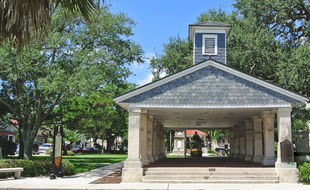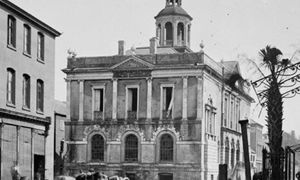You Probably Didn't Notice: The Negligence Towards Slave Auction Sites
Memorials to groups that have experienced extreme amounts of strife can be a powerful experience to its visitors. Several bare-bones structures like Auschwitz and the Door of No Return allow visitors to experience the site. At these sites, horrible things happened to different groups of people at various points in time and there is absolutely no mistaking that. Its visitors are able to experience for themselves the various emotions that run through them when they learn about the horrible things that happened at each of these memorials by experiencing them for themselves. At other memorials, however, it is more difficult to gain the same experience and become informed about the atrocities that occurred there. In particular, at several monuments where slaves were sold in the South, there is a lack of information about this particular atrocity. Slave markets took in slaves from Africa or slaves born in the states and separated them from their families and loved ones. According to Harvard historian Walter Johnson, one million human beings were sold at state-ordered sales in the South between 1820 and 1860, and millions more were sold in private sales. What is important about this information in relation to the location at which they happen is that it is rarely presented to the visitors of these sites. The negligence in dedication and preservation that local governments have towards the sites at which slaves were sold takes away the experiential learning capacity that these sites could have.
The Plaza de la Constitution is a place of gathering and tourism in St. Augustine Florida. There are several monuments in the Plaza, including the Foot Soldiers Monument which commemorates St. Augustine residents who fought for civil rights in the city, canons that commemorate the city’s participation in the civil war, and a monument to the Korean War. There's a relatively unassuming structure in the plaza as well. It’s a rectangular, open-air structure with a blue rectangular roof and a spire. If one were to enter the structure from the wrong side they would miss the two plaques dedicated to the structure. The first says nothing about the slaves sold there while the other says it was a place of ‘public auction’ and then ever since called the Slave Market. Beyond these two signs, one that doesn’t even mention the horrible atrocity that occurred here, and the other which is poorly placed on one of the Slave Market’s pillars, there is no indication that such a brutal example of forced migration occurred at this location. The local government has not made dedications nearly as powerful as they have done to memorials to other examples of strife in the same park. This is an obvious indication that the local government of St. Augustine has a disregard for the slave auctions that occurred here.
The Exchange and Provost building is a beautiful example of the Georgian-Palladian style in Charleston South Carolina. The building has brown brick, crown molding, and large windows as a symbol of the town's wealth. There are two main floors with a dungeon in its basement. It also has a large brick courtyard in the front of the building facing some sort of town square. In this courtyard, if one was not to be informed of the history by one of the guides in the area, they would have no idea that slaves were sold here. Beyond two sentences on the city's website, there is no physical dedication to the slaves that were sold here. In fact, the slave-trading history of this memorial has been swept up in the rest of this building's albeit long history.




